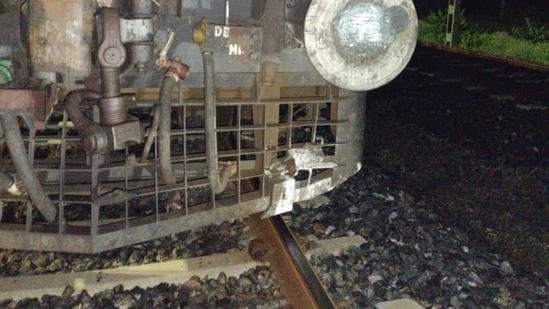In a chilling incident reminiscent of the 2016 Kanpur train derailment, a potential disaster was narrowly avoided in Rajasthan’s Ajmer district after cement blocks were found placed deliberately on the railway tracks. The timely intervention of railway authorities prevented what could have been a major accident, raising concerns about security on India’s expansive rail network. This incident, which occurred on September 9, 2024, has sparked fears of sabotage and drawn parallels to past tragedies involving deliberate attempts to derail trains.
The incident unfolded when alert railway personnel, conducting routine inspections, discovered cement blocks strategically positioned on the tracks near Ajmer. The area is a relatively isolated stretch, making it a vulnerable target for such sabotage attempts. Authorities responded swiftly by halting train operations in the region, removing the blocks, and conducting a thorough inspection of the tracks to ensure they had not been damaged. Train services resumed after the tracks were cleared and deemed safe, averting what could have been a catastrophic derailment.
This incident is hauntingly similar to the 2016 Kanpur train derailment, where an act of sabotage led to the derailment of the Indore-Patna Express, resulting in the loss of over 150 lives. In that case, it was later revealed that objects had been deliberately placed on the tracks, causing the train to crash. The discovery of cement blocks in Ajmer has reignited fears of similar attempts to target trains, bringing back memories of that horrific accident and raising concerns about railway security.
Railway officials have confirmed that the placement of the cement blocks in Ajmer was intentional, indicating a clear act of sabotage. The local police have been informed, and an investigation has been launched to identify those responsible. Authorities are looking into whether the act was a form of vandalism or part of a more organized attempt to cause harm. The incident has put the spotlight on the vulnerability of India’s rail infrastructure, which has been targeted in the past by those looking to cause widespread damage.
The railways are one of India’s primary modes of transportation, with millions of passengers relying on trains daily. The safety of this vast network is a critical issue, and any threat to it has the potential to cause widespread panic. The placement of cement blocks on tracks in Ajmer has underscored the need for enhanced security measures, especially in isolated areas that are more susceptible to sabotage attempts. The incident has prompted renewed calls for increased surveillance and monitoring along rail routes to prevent future attempts.
While no passengers or trains were harmed in the Ajmer incident, the implications of such an act are significant. Sabotage attempts like this not only threaten the lives of passengers but also highlight the ongoing vulnerabilities in India’s railway system. The incident has led to widespread discussions about how to improve the safety and security of the rail network, especially in light of past incidents like the Kanpur derailment.
In response to the Ajmer incident, railway authorities have promised to step up security measures, particularly in remote areas. Increased patrolling, more frequent inspections, and the use of technology such as drones and CCTV surveillance are some of the measures being considered. Additionally, local law enforcement agencies are working closely with railway officials to investigate the incident and prevent any future attempts at sabotage.
The discovery of cement blocks on the tracks in Ajmer is a stark reminder of the ongoing threats to public safety and the importance of vigilance in ensuring the security of India’s railways. While the swift actions of railway personnel and authorities prevented a disaster this time, the incident has sent shockwaves through the community, reigniting fears of train sabotage and underscoring the need for constant vigilance. As the investigation continues, authorities are focused on identifying those responsible and ensuring that such a dangerous attempt is not repeated.
This incident, though resolved without any immediate harm, serves as a critical warning. With India’s railways serving as the lifeblood of the country’s transportation system, ensuring the safety of every passenger remains a top priority for both the government and railway authorities.

